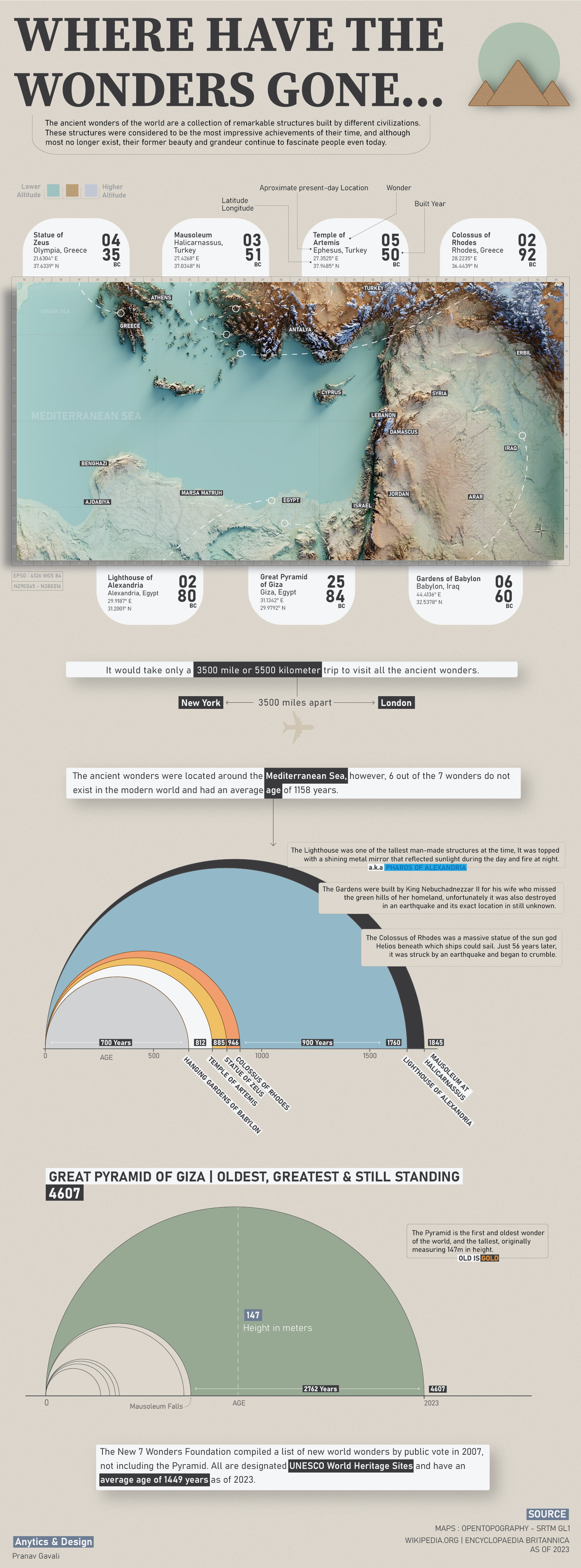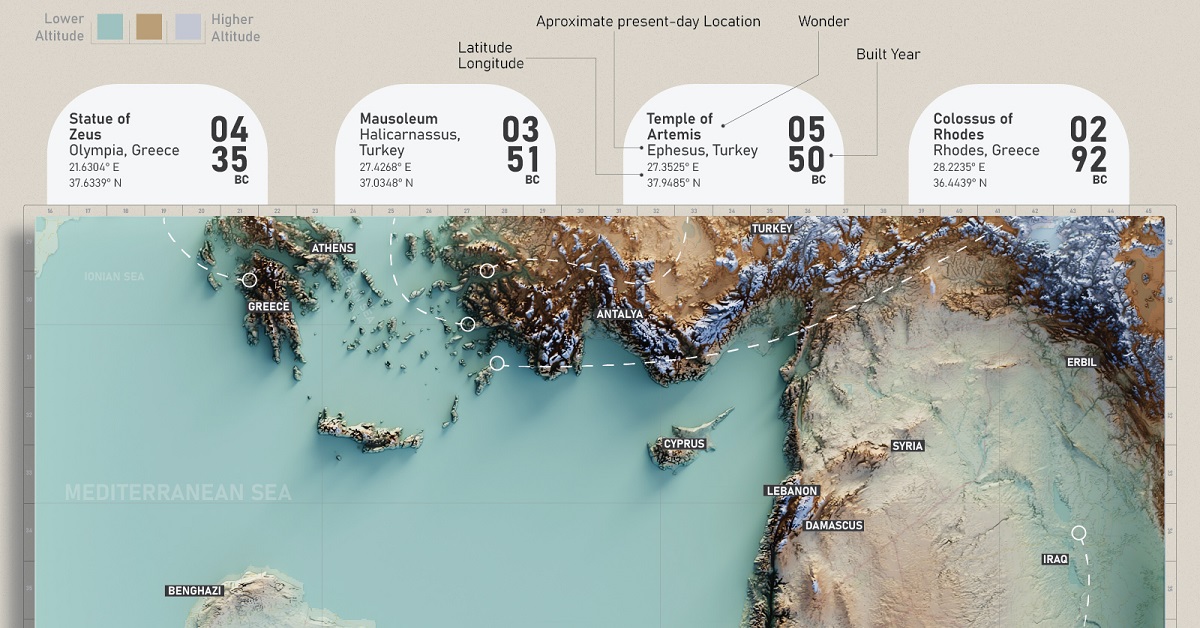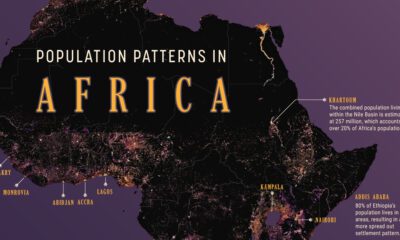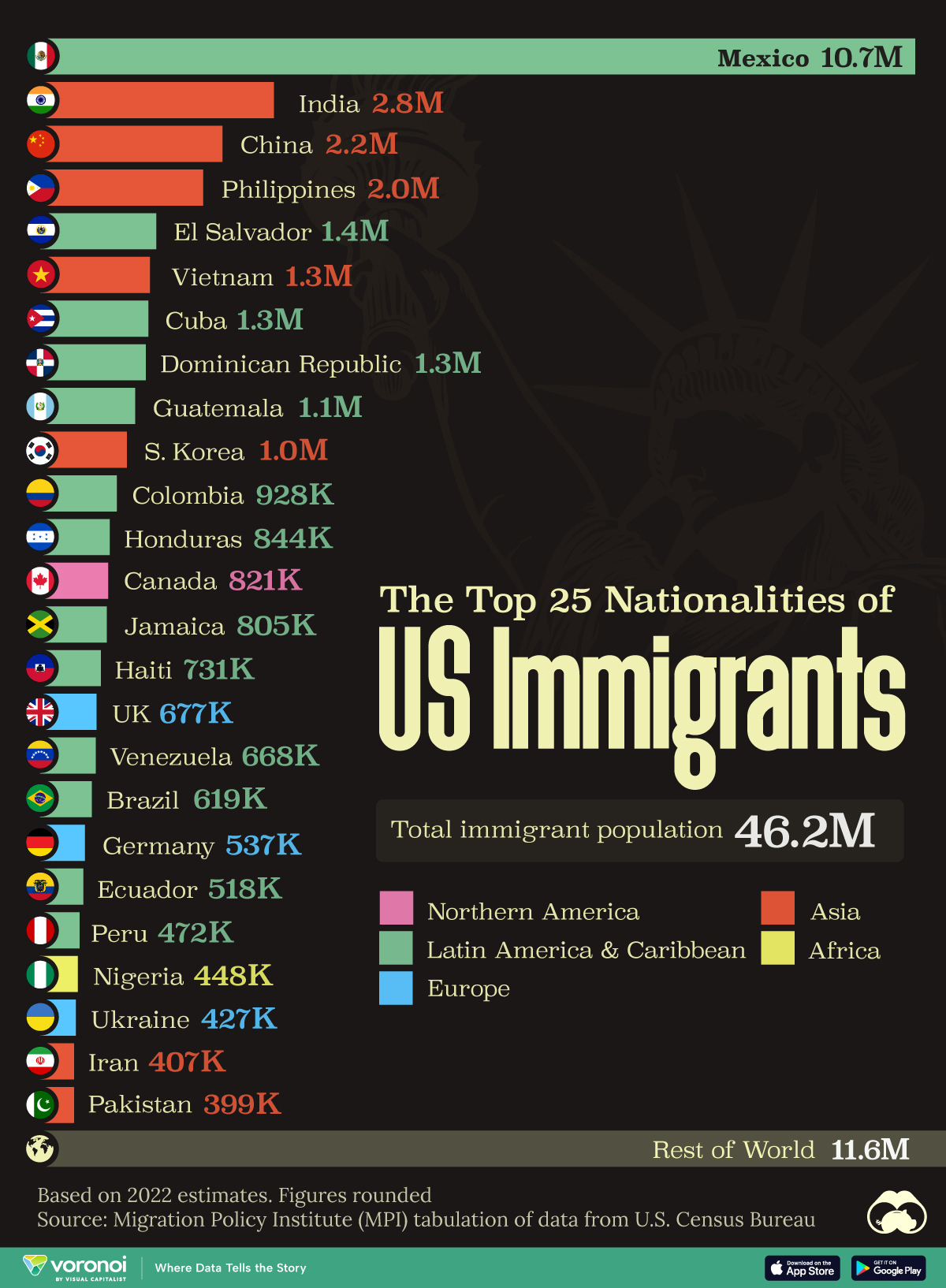Misc
Mapped: The Ancient Seven Wonders of the World

The Ancient Seven Wonders of the World
From skyscrapers that defy gravity to tunnels below the sea, mankind’s civil engineering feats are all around us.
The complexity of older structures like the Great Wall of China, Chichén Itzá, and the Taj Mahal continue to captivate and fascinate visitors today, but it’s worth noting that “wonders” such as these are not a modern concept.
As far back as the 2nd century BCE, ancient guide books and poems were being written by Greeks that had toured the extent of Alexander the Great’s kingdoms, giving us the original “seven wonders of the world” from the Hellenistic world they knew at the time.
This graphic by Pranav Gavali looks at the original ancient seven wonders, including their modern-day locations and features, using data from Encyclopedia Britannica and Wikipedia.
Where Were the Seven Wonder of the World?
The original seven wonders of the world were built around the Mediterranean Sea and in the Middle East over a span of 3,000 years, all before the Common Era.
| Wonders | Modern Location | Year Created |
|---|---|---|
| Great Pyramid of Giza | Egypt | 2,584 BCE |
| Hanging Gardens of Babylon | Iraq | 600 BCE |
| Temple of Artemis at Ephesus | Turkey | 550 BCE |
| Statue of Zeus at Olympia | Greece | 435 BCE |
| Mausoleum at Halicarnassus | Turkey | 351 BCE |
| Colossus of Rhodes | Greece | 292 BCE |
| Lighthouse of Alexandria | Egypt | 280 BCE |
From the Great Pyramid of Giza in Egypt to the Colossus in Rhodes, each wonder represents a different aspect of human ambition and ingenuity.
And while only one of the wonders still stands today, their legacy lives on. Let’s explore the stories behind the seven wonders of the world:
1. The Great Pyramid of Giza
— 2,584 BCE
The ancient Egyptians believed that death was a pitstop on the way to a new life, and royals were buried in massive royal tombs.
This 4,500-year-old pyramid was one such tomb, built for Pharaoh Khufu. Standing tall at an initial 147 meters (139 meters today), this monument is the oldest and largest of the seven wonders of the world. It is also the only ancient wonder still standing.
2. The Hanging Gardens of Babylon
— 600 BCE
The Gardens of Babylon are believed to have provided a stunning oasis in the middle of the desert in 600 BCE, with tiered gardens of trees, shrubs, and vines.
The common belief is that King Nebuchadnezzar II built these gardens for his wife Amytis, who missed the lush hills of her homeland Media (northwest Iran).
However, their existence has been disputed by historians which have struggled to find concrete archaeological evidence. They are commonly believed to have been destroyed by an earthquake after 700 years, making them the shortest-lived ancient wonder.
3. The Temple of Artemis at Ephesus
— 550 BCE
Built in the 6th century BCE, this temple was dedicated to the Greek goddess Artemis. Even larger than a present-day football field and with more than 127 columns, it was the first all-marble temple ever built in Greece.
It was destroyed and rebuilt several times, with the third phase listed as the grandest world wonder. It was finally closed and destroyed around the start of the 5th century.
4. The Statue of Zeus at Olympia
— 435 BCE
In 435 BC, Greek sculptor Phidias was tasked with creating an enormous statue of Zeus in Olympia, the site of Temple of Zeus and the ancient Olympic Games.
The statue was seated on a throne made from ivory, gold, and wood, holding a massive scepter supporting an eagle in one hand and a small statue of Nike, the goddess of victory, in the other. It was believed to have been destroyed in the times of the Romans around 400 CE, but whether that was in a fire or if it were broken into pieces and sent to different cities, is unknown.
5. The Mausoleum at Halicarnassus
— 351 BCE
Much like today’s Alexandria or Babylon, Halicarnassus was a thriving ancient city and capital of Caria. Its most famous ruler was Mausolus, the king of Caria, and when building the capital he also commissioned an elaborate above-ground tomb for himself.
Built in 351 BCE, the Mausoleum was over 45 meters tall and adorned with stunning sculptures and intricate carvings. Though it was destroyed by many local earthquakes between the 12th and 15th centuries, its legacy lives on as the word mausoleum went on to define stately, magnificent tombs.
6. The Colossus of Rhodes
— 292 BCE
Back in 304 BCE, Greece’s harbor city of Rhodes successfully resisted a year-long siege, and its people celebrated by using abandoned weaponry to create an enormous statue of the ancient Greek god of the Sun, Helios.
It stood over the port entry to the city, and was about the same height (33 meters) as the Statue of Liberty from feet to crown. And though the Colossus technically fell after a 226 BCE earthquake, it lay on the ground and was still impressive for another 800 years.
7. The Lighthouse of Alexandria
— 280 BCE
Lighthouses serve as beacons for all those at sea, and the Lighthouse of Alexandria was no different. However, its impressive architectural design of 100 meters of sandstone and limestone was far from simple, being one of the world’s tallest man-made structures for centuries.
Built during the time of pharaoh Ptolemy II Philadelphus on the small island of Pharos, it was said to have been crowned with a mirror that reflected sunlight during the day and fire at night, making it visible from up to 50 km away. Though the lighthouse was damaged in earthquakes and survived until 1480, “pharos” became the root word for lighthouse in Greek and many Romance languages.
The New Seven Wonders of the World
To reflect the continued usage and understanding of the term “seven wonders of the world,” the New 7 Wonders Foundation started a campaign to choose seven new wonders in 2001.
After a large and lengthy campaign, with some countries advocating for statues and others downplaying the new list, the final list of wonders was announced in 2007:
| New Wonders | Location | Year Created |
|---|---|---|
| Great Wall of China | China | 700 BCE |
| Petra | Jordan | 312 BCE |
| Colosseum | Italy | 80 CE |
| Chichén Itzá | Mexico | 600 CE |
| Machu Picchu | Peru | 1450 CE |
| Taj Mahal | India | 1643 CE |
| Christ the Redeemer | Brazil | 1931 CE |
And though it was not included as an option as an attempt to find “new” wonders, the Great Pyramid of Giza was still granted honorary status as a world wonder.

This article was published as a part of Visual Capitalist's Creator Program, which features data-driven visuals from some of our favorite Creators around the world.
Misc
The Top 25 Nationalities of U.S. Immigrants
Mexico is the largest source of immigrants to the U.S., with almost 11 million immigrants.

The Top 25 Nationalities of U.S. Immigrants
This was originally posted on our Voronoi app. Download the app for free on iOS or Android and discover incredible data-driven charts from a variety of trusted sources.
The United States is home to more than 46 million immigrants, constituting approximately 14% of its total population.
This graphic displays the top 25 countries of origin for U.S. immigrants, based on 2022 estimates. The data is sourced from the Migration Policy Institute (MPI), which analyzed information from the U.S. Census Bureau’s 2022 American Community Survey.
In this context, “immigrants” refer to individuals residing in the United States who were not U.S. citizens at birth.
Mexico Emerges as a Leading Source of Immigration
Mexico stands out as the largest contributor to U.S. immigration due to its geographical proximity and historical ties.
Various economic factors, including wage disparities and employment opportunities, motivate many Mexicans to seek better prospects north of the border.
| Country | Region | # of Immigrants |
|---|---|---|
| 🇲🇽 Mexico | Latin America & Caribbean | 10,678,502 |
| 🇮🇳 India | Asia | 2,839,618 |
| 🇨🇳 China | Asia | 2,217,894 |
| 🇵🇭 Philippines | Asia | 1,982,333 |
| 🇸🇻 El Salvador | Latin America & Caribbean | 1,407,622 |
| 🇻🇳 Vietnam | Asia | 1,331,192 |
| 🇨🇺 Cuba | Latin America & Caribbean | 1,312,510 |
| 🇩🇴 Dominican Republic | Latin America & Caribbean | 1,279,900 |
| 🇬🇹 Guatemala | Latin America & Caribbean | 1,148,543 |
| 🇰🇷 Korea | Asia | 1,045,100 |
| 🇨🇴 Colombia | Latin America & Caribbean | 928,053 |
| 🇭🇳 Honduras | Latin America & Caribbean | 843,774 |
| 🇨🇦 Canada | Northern America | 821,322 |
| 🇯🇲 Jamaica | Latin America & Caribbean | 804,775 |
| 🇭🇹 Haiti | Latin America & Caribbean | 730,780 |
| 🇬🇧 United Kingdom | Europe | 676,652 |
| 🇻🇪 Venezuela | Latin America & Caribbean | 667,664 |
| 🇧🇷 Brazil | Latin America & Caribbean | 618,525 |
| 🇩🇪 Germany | Europe | 537,484 |
| 🇪🇨 Ecuador | Latin America & Caribbean | 518,287 |
| 🇵🇪 Peru | Latin America & Caribbean | 471,988 |
| 🇳🇬 Nigeria | Africa | 448,405 |
| 🇺🇦 Ukraine | Europe | 427,163 |
| 🇮🇷 Iran | Middle East | 407,283 |
| 🇵🇰 Pakistan | Asia | 399,086 |
| Rest of World | 11,637,634 | |
| Total | 46,182,089 |
Mexicans are followed in this ranking by Indians, Chinese, and Filipinos, though most immigrants on this list come from countries in the Latin American and Caribbean region.
On the other hand, only three European countries are among the top sources of U.S. immigrants: the UK, Germany, and Ukraine.
Immigration continues to be a significant factor contributing to the overall growth of the U.S. population. Overall population growth has decelerated over the past decade primarily due to declining birth rates.
Between 2021 and 2022, the increase in the immigrant population accounted for 65% of the total population growth in the U.S., representing 912,000 individuals out of nearly 1.4 million.
If you enjoyed this post, be sure to check out Visualized: Why Do People Immigrate to the U.S.? This visualization shows the different reasons cited by new arrivals to America in 2021.
-

 Personal Finance1 week ago
Personal Finance1 week agoVisualizing the Tax Burden of Every U.S. State
-

 Misc7 days ago
Misc7 days agoVisualized: Aircraft Carriers by Country
-

 Culture1 week ago
Culture1 week agoHow Popular Snack Brand Logos Have Changed
-

 Mining1 week ago
Mining1 week agoVisualizing Copper Production by Country in 2023
-

 Misc1 week ago
Misc1 week agoCharted: How Americans Feel About Federal Government Agencies
-

 Healthcare1 week ago
Healthcare1 week agoWhich Countries Have the Highest Infant Mortality Rates?
-

 Demographics1 week ago
Demographics1 week agoMapped: U.S. Immigrants by Region
-

 Maps1 week ago
Maps1 week agoMapped: Southeast Asia’s GDP Per Capita, by Country















